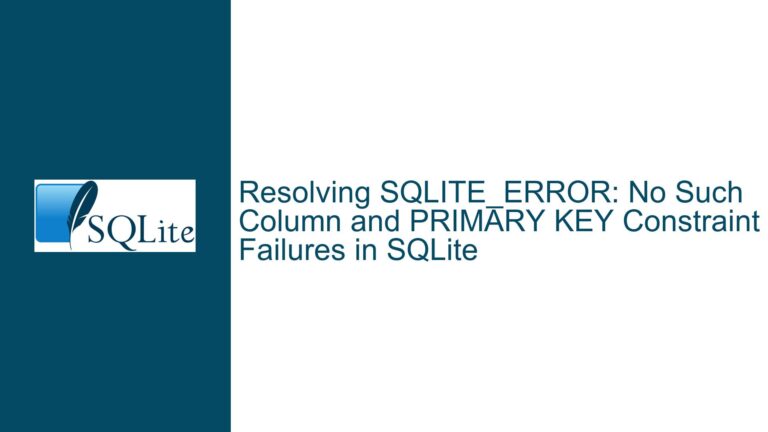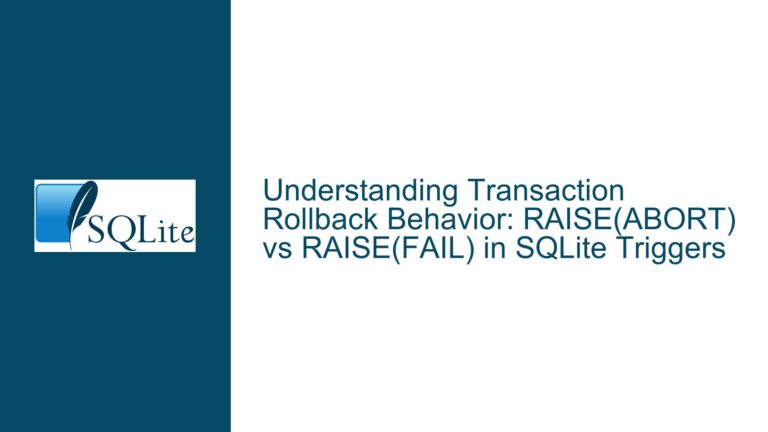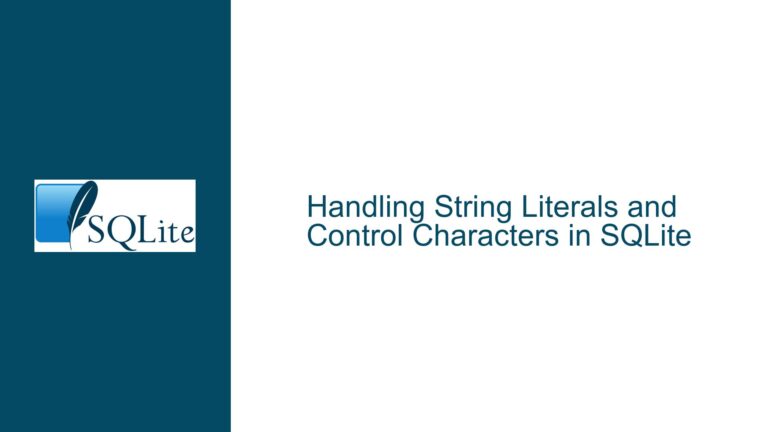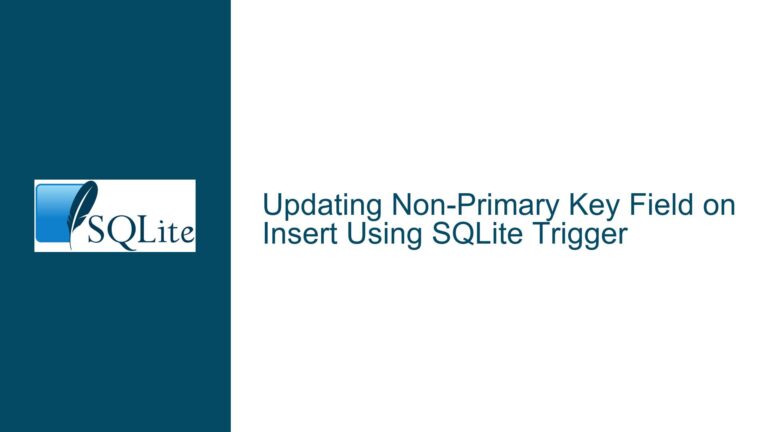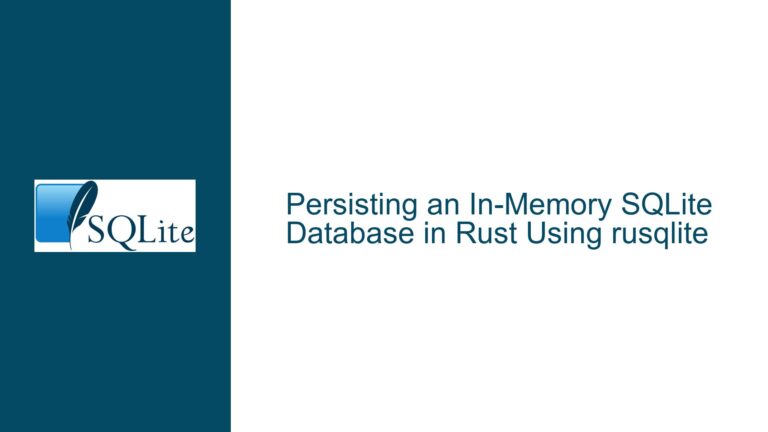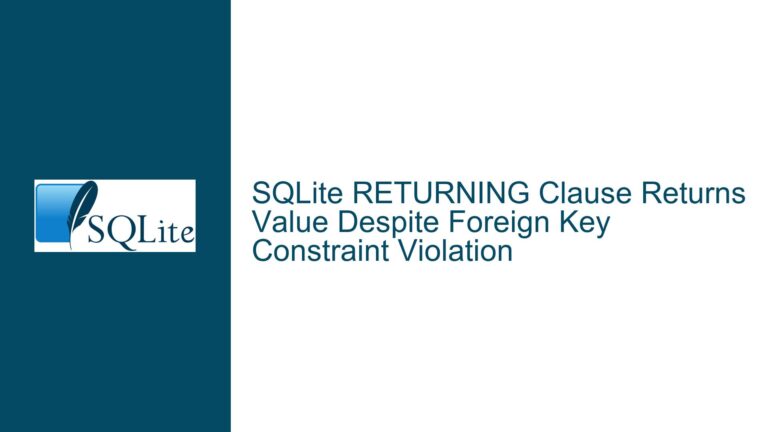Resolving Duplicate Word Entries Through Aggregation and Schema Modifications in SQLite
Structural Limitations of Direct Updates on Aggregated Data
The core challenge arises from attempting to modify a table while simultaneously aggregating its data through the GROUP_CONCAT function. SQLite’s UPDATE syntax operates on individual rows and lacks native support for window functions or subqueries that reference the same table being modified. When executing SELECT word, group_concat(meaning, '/') FROM Table1 GROUP BY word, the database engine creates a transient result set containing merged meanings for duplicate words. However, directly writing this result back into the original table would require either:
- Deleting all existing rows for each grouped word
- Inserting a single consolidated row per word group
- Preserving transactional integrity throughout the process
SQLite’s constraint enforcement and locking mechanisms prevent such bulk modifications through a single UPDATE statement. The absence of row-specific identifiers in the original table exacerbates this issue, as there is no reliable way to target individual duplicates for deletion while retaining the aggregated row. Attempting to execute an UPDATE with GROUP_CONCAT would either produce constraint violations (if word is a primary key) or result in partial updates that leave residual duplicates.
This limitation stems from SQLite’s ACID-compliant design, which prioritizes data consistency over complex in-place mutations. The engine cannot simultaneously maintain a stable snapshot of Table1 for the GROUP BY operation while modifying that same table’s structure. Workarounds must therefore decouple the aggregation phase from the data persistence phase through intermediate storage mechanisms.
Schema Immutability and Dependency Management Challenges
The viability of table replacement strategies depends on the existing database schema’s complexity. While creating Table2 as a consolidated version of Table1 appears straightforward, several hidden dependencies may render this approach problematic:
Triggers
AFTER INSERT/UPDATE/DELETE triggers defined on Table1 would not automatically propagate to Table2 during the replacement process. Any business logic embedded in these triggers would need manual reimplementation. Conversely, triggers on other tables that reference Table1 through foreign keys would require adjustment to point to the new table structure.
Views and Indexes
Materialized views or indexes built on Table1 would become invalid upon table deletion. For example, a view created with CREATE VIEW v1 AS SELECT * FROM Table1 would throw a "no such table" error after Table1 is dropped, even if immediately renamed. This necessitates either redefining views post-migration or using temporary tables to stage the data transition.
Foreign Key Constraints
If Table1 participates in foreign key relationships with other tables, the DROP TABLE operation would fail unless PRAGMA foreign_keys=OFF is set beforehand. However, disabling foreign key checks introduces risks of orphaned records if not carefully managed during the schema transition.
Virtual Tables and Extensions
Specialized table types like FTS5 virtual tables or geographic extensions require specific creation parameters that a simple CREATE TABLE ... AS SELECT cannot replicate. Migrating these would demand explicit recreation using their original module configurations.
Atomic Replacement Strategy with Transactional Safeguards
The optimal solution combines schema migration techniques with SQLite’s transactional guarantees to ensure data integrity. This approach involves seven key phases:
Phase 1: Schema Analysis and Preparation
Extract Table1‘s complete schema definition using:
SELECT sql FROM sqlite_schema WHERE name='Table1';
This returns the original CREATE TABLE statement, essential for recreating any constraints, defaults, or indexes on Table2. If the original table lacks a primary key (as implied by the duplicate word entries), explicitly add PRIMARY KEY NOT NULL during recreation:
CREATE TABLE Table2 (
word TEXT PRIMARY KEY NOT NULL,
meaning TEXT
) WITHOUT ROWID;
The WITHOUT ROWID clause optimizes storage for tables with explicit primary keys, reducing both space and lookup times.
Phase 2: Temporary Table Population
Instead of creating a permanent Table2, use a temporary table to stage aggregated data:
CREATE TEMP TABLE TempConsolidated (
word TEXT PRIMARY KEY NOT NULL,
meaning TEXT
) WITHOUT ROWID;
INSERT INTO TempConsolidated
SELECT word, group_concat(meaning, ' / ')
FROM Table1
GROUP BY word;
Temporary tables exist only for the connection’s duration and avoid polluting the main schema. Verify aggregation correctness through:
SELECT count(*) FROM TempConsolidated; -- Expected unique word count
SELECT * FROM TempConsolidated WHERE word LIKE '%test%'; -- Spot checks
Phase 3: Dependency Isolation
Disable automatic triggers and foreign key enforcement before modifying Table1:
PRAGMA defer_foreign_keys = ON;
PRAGMA legacy_alter_table = OFF;
These settings allow table restructuring while deferring constraint checks until transaction commit.
Phase 4: Atomic Data Replacement
Within an explicit transaction:
BEGIN EXCLUSIVE;
DELETE FROM Table1;
INSERT INTO Table1 (word, meaning)
SELECT word, meaning FROM TempConsolidated;
COMMIT;
The EXCLUSIVE lock mode prevents concurrent writes during this critical phase. For large datasets, batch the INSERT using LIMIT and OFFSET to avoid statement memory overflows.
Phase 5: Index and Trigger Reconciliation
Regenerate any indexes that existed on Table1 using the schema information gathered in Phase 1. If triggers modified data during insertion, test their behavior with:
INSERT INTO Table1 (word, meaning) VALUES ('newword', 'test');
DELETE FROM Table1 WHERE word = 'newword';
Monitor sqlite_triggers for unexpected behavior.
Phase 6: Validation and Rollback Preparedness
Before finalizing, verify data integrity through:
PRAGMA integrity_check;
PRAGMA foreign_key_check;
Keep a backup of the original Table1 either as a file copy or via:
ATTACH DATABASE 'backup.db' AS bak;
CREATE TABLE bak.Table1_backup AS SELECT * FROM main.Table1;
This enables quick restoration if post-migration issues emerge.
Phase 7: Performance Tuning
After consolidation, analyze query plans:
EXPLAIN QUERY PLAN SELECT * FROM Table1 WHERE word = 'example';
Ensure the primary key index is being used via SEARCH TABLE Table1 USING INDEX sqlite_autoindex_Table1_1 (word=?). For large text blobs in meaning, consider enabling compression or moving rarely accessed data to auxiliary tables.
Edge Case Handling and Long-Term Maintenance
Partial Duplicates
If some word entries should remain duplicated based on ancillary columns not present in the schema, modify the aggregation logic to include those in the GROUP BY clause:
GROUP BY word, additional_column;
Delimiter Collisions
When using ' / ' as the GROUP_CONCAT separator, scan for existing occurrences in meaning entries:
SELECT count(*) FROM Table1 WHERE meaning LIKE '% / %';
Use an uncommon delimiter like ␟ (Unicode Unit Separator) if collisions are frequent.
Version Compatibility
The WITHOUT ROWID syntax requires SQLite 3.8.2+. For legacy systems, omit this clause and accept standard rowid tables with slightly reduced performance.
Automated Testing
Implement regression tests using SQLite’s TCL testing framework to validate future schema changes:
db eval {SELECT group_concat(meaning) FROM Table1 WHERE word='duplicate'} {
if {$result ne "expected/concatenated"} { error "Test failed" }
}
This comprehensive approach balances immediate duplication resolution with long-term schema stability, ensuring maintainability while leveraging SQLite’s core strengths in transactional data management.

